Conclusions from the Academic Research
We looked at research papers from the last 30 years to evaluate our set of teaching strategies undertaken in our Japanese language learning application called Japanese Complete. We found that the scholarly and academic studies referred to confirm:
- Kanji [logographs of mainland Asian origin] are categorized as the main impediment in acquisition of the Japanese language and anything to ease their acquisition from rote-memorization will help learners greatly.
- Computer aided learning of Japanese is superior to textbook-based learning when paired with timely and useful feedback for the learner, with politeness language, grammar, kanji, and more. [4, 5, 7, 12, 17]
- Kanji are processed by different parts of the brain compared to English letters and Hiragana mora, suggesting that placing special emphasis on learning Kanji as glyphs or graphics with associated meanings first establishes a firm foundation upon which to then learn readings and pronunciations. [2, 6]
- Kanji have logographic as well as phonographic value; cultural, etymological, and mnemonic strategies are not only more effective than rote-memorization strategies for learning, they also remove a lot of anxiety and perceived inscrutability of kanji, making kanji learning fun and intriguing instead of a chore. The main techniques presented in these papers include component-analysis of kanji [what we call subkanji learning], and pairing kanji with graphical and mnemonic aides such as stories or imaginal scenes. [6, 7, 10, 11, 14, 15]
- It is very likely that native speakers of languages featuring kanji create some sort of meaning-word associated with each kanji, whether able to give voice to it or not (“unconscious knowledge”), suggesting strongly that by teaching kanji meaning-words first one is creating a very helpful and direct shortcut to their successful assimilation. [6, 9, 10]
- One paper suggests the use of an “orthographic gradient” where terms are first shown as color-coded Hiragana, and later instances are shown as color-coded kanji using the same coloration, allowing learners to make an implied association of equality. This idea of “orthographic gradient” confirms the efficacy of our innovative approach “Kanji in English Context” where we t取ke kanji and pl置ce them in an 英ngl語sh c文nt脈xt [take, place, English, context] to expedite acquisition and increase familiarity with the plurality of [English] words kanji can represent. [11, 16]
- Acquisition of Japanese grammar and sequence continues to be the most challenging part of learning the language for 1st, 2nd, and 3rd year students, suggesting that the focus for the first several semesters of learning ought be grammar-focused. Nouns are acquired at a linear rate no matter the level of grammar competency, and thus it would suggest that the learning of nouns can actually be greatly delayed without any negative impact on comprehension; rather, focus on grammar first would result in greatly improved comprehension when nouns are later added to one’s cogent grammar understanding.
- Very Accurate Japanese Pitch Accent can be trained and learned swiftly with the right learning materials (showing pitch contours on screen and having learners listen and repeat). [17]
- One’s native language shapes how one acquires second+ languages. [3, 13]

Scholarly and Academic Works Cited
[1] Phonological processing of Japanese Kanji and Chinese characters in bilingual Japanese : An fMRI study (2017)
https://ieeexplore.ieee.org/document/8015970
“The result showed that our bilingual Japanese subjects have large overlaps in the neural substrates for phonological processing of both native and second language. Our finding supports the idea that the neural systems of second language reading are shaped by native language.”
[2] Japanese and English sentence reading comprehension and writing systems: An fMRI study of first and second language effects on brain activation. (2009)
https://pubmed.ncbi.nlm.nih.gov/19946611/
Parts of the brain that are engaged when native Japanese readers process English, Hiragana, and Kanji:

“Functional magnetic resonance imaging (fMRI) was used to compare brain activation from Japanese readers reading hiragana (syllabic) and kanji (logographic) sentences, and English as a second language (L2). Kanji showed more activation than hiragana in right-hemisphere occipito-temporal lobe areas associated with visuospatial processing; hiragana, in turn, showed more activation than kanji in areas of the brain associated with phonological processing. L1 results underscore the difference in visuospatial and phonological processing demands between the systems. Reading in English as compared to either of the Japanese systems showed more activation in inferior frontal gyrus, medial frontal gyrus, and angular gyrus. The additional activation in English in these areas may have been associated with an increased cognitive demand for phonological processing and verbal working memory.”
[3] Comparative Spatial Semantics and Language Acquisition:Evidence from Danish, English, and Japanese (1994)
“Perhaps the most important finding is that in all three languages that we have analysed acquisition appears to take place in two phases, during the first of which the child gradually acquires six to eight simple forms corresponding to ‘basic’ spatial meanings encoded in the target language.”
“In the second phase of acquisition, the child’s productive repertoire and the frequency of its use increase in a way that is reminiscent of (though perhaps less dramatic than) the ‘vocabulary explosion’ in nominal usage. The extension of the repertoire takes different courses, depending on the structure of the target language. In all languages it can be expected that the repertoire within the form class which is dominant in expressing spatial relational meaning will continue to expand, and that this will remain the most frequently employed vehicle for the child’s expression of spatial relational meaning throughout and perhaps beyond the third year of life.”
“In languages, such as Japanese, in which spatial relational meaning is overtly distributed over different form classes, the second phase will involve both an increase in the range of types controlled in the dominant form class (in this case,verbs), and the extension of the acquisition process to the other form classes (in this case, particles and nouns). Both the slow pace of acquisition in the non-dominant forms classes, and the fact that the meanings initially expressed using nouns are cognate with those already expressed using verbs, suggest that, in Japanese too, the learning process continues to be governed in the second phase by a conservative strategy. It can perhaps be seen as follows: the child employs the already acquired meanings as clues for the establishment of new centres in new form classes for the repetition with respect to these new form classes of the radial strategy already successfully employed with respect to the dominant form class.”
[4] Supporting the acquisition of Japanese polite expressions in context-aware ubiquitous learning (2010)
http://www.academia.edu/download/50315553/ijmlo.2010.03263720161114-19604-1c5exmp.pdf
“To support the foreigners learning JPE [Japanese Politeness Expressions], a PDA-based context-aware language learning support environment was proposed. This environment supports the learners to learn JPE according to the different situations in the real world. There are two version of the prototype system for this environment. In this paper, design, implementation and evaluation of JAPELAS2 are presented. From the experiment, we found the system provides the correct polite-expression based on hyponymy, social distance and situation through the identification of the target user and the location. The experiment showed that the system was quite useful and using this system made understanding the appropriate level of politeness easy by changing roles and situations.”
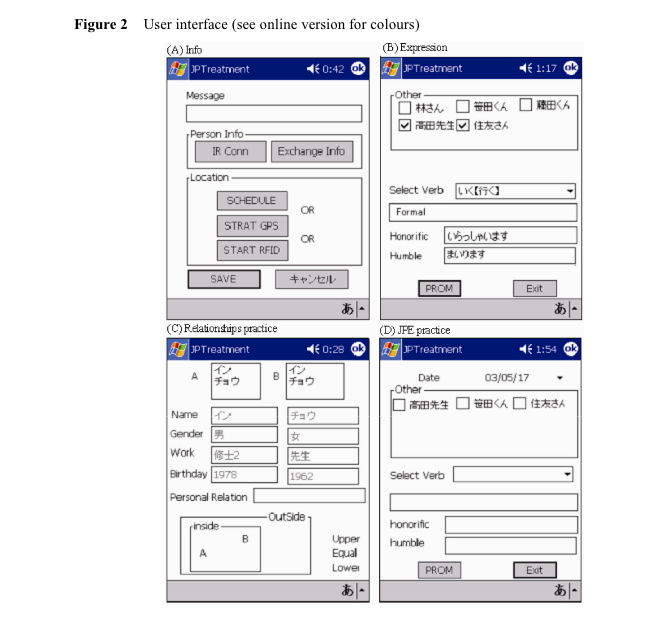
[5] COMPUTER VS. WORKBOOK INSTRUCTION IN SECOND LANGUAGE ACQUISITION (1996)
https://journals.equinoxpub.com/CALICO/article/viewFile/23393/19398
“The results of the study show that given the same grammar notes and exercises, ongoing intelligent computer feedback is more effective than simple workbook answer sheets for developing learners’ grammatical skill in producing Japanese particles and sentences. A significant difference between Nihongo-CALI and the workbook instruction was observed in the production tests but not in the comprehension tests. This is consistent with Flynn’s hypothesis that grammatical competence is less critical in comprehension than in production. As suggested by Pederson and Dunkel, the present study also confirms that the use of a medium (i.e., computer) alone does not bring better effects; rather the quality of the messages produced by the medium affects the result. This is based on the fact that the intelligent version of Nihongo-CALI is significantly more effective than the workbook instruction”
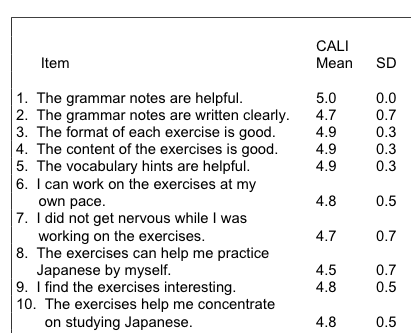
[6] L2 learners’ attitudes toward, and use of, mnemonic strategies when learning Japanese Kanji (2013)
“This study investigated kanji learning (the memorization of Japanese written characters) of university students of Japanese, in order to evaluate students’ use of mnemonic strategies. The study applied in-depth qualitative methods to broaden the understanding of how foreign language learners use mnemonics when learning kanji. Data were collected over the duration of a year in the form of interviews, stimulated recall sessions, and a questionnaire on mnemonic usage. The study found that while mnemonics are useful to memorize kanji and kanji components when applied in a meaningful way, an overreliance on this strategy can have negative effects for the learner. The study highlighted numerous accounts of the meaning of a kanji being lost in overly complex mnemonic strategies. Another limitation of mnemonic strategies was associations being made with the meaning of kanji and not with how it was read, causing an inability to read kanji in Japanese.”

Overcoming Overreliance and our Kanji-in-English-Context Newsletter
In Japanese Complete, we mitigate the shortcomings of “overreliance” on kanji mnemonics by providing our innovative “Kanji in English Context” where polysemy (multiple meanings) are reinforced using relevant English words smashed with kanji masks. We have created a newsletter just for this here.
Example: D為ing ev日ryd常y th事ngs with j喜y [Doing everyday things with joy]
[7] Use of Mrs.Kanji Web Application to Enhance Japanese Kanji Learning (2019)
https://download.atlantis-press.com/article/125938096.pdf
“This paper presents Mrs kanji,a web application for learning Japanese kanji characters developed by authors over the past one and a half years. This study aims to create and develop applications that are used for learning and memorizing kanji letters based on the website application, which contains 101 letters that have been grouped in a thematic form accompanied by illustrative picture learning models, mnemonic hints in English and Japanese, how to read meaning (Indonesian and English), examples of words, search features (hiragana, romaji, kanji,and meaning), glossary and exercises and three types of practice or quiz. The method used in this study is DBR (Design-Based Research) with a descriptive contextual model. The product outcome is problem-based learning so that the survey was first carried out with a non-test instrument in the form of a questionnaire taken randomly or random sampling twice with the first survey results participated by 52 respondents consisting of beginners and people who were proficient in Japanese with the aim to identifying the needs of users regarding the applications. The second survey was administered to19 people consisting of users and experts who tested and evaluated the website-based applications. The results of the data analysis show that the application has fulfilled the aspects of effectiveness, validity,and practicality with the category of ‘Good.’ The available kanji is incomplete so it is recommended that further research can develop this application better.”
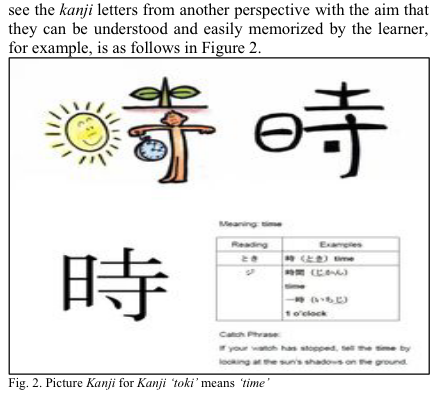
[8] Mnemonic Networks: Multiple Paths to Learning Sino-Japanese Characters (2017)
http://mail.readingmatrix.com/files/17-798967kw.pdf
“The primary impediment to literacy in Japanese is kanji proficiency. The ostensible reason kanji present such a formidable challenge, especially for the second language learner, is the combined effect of their quantity and complexity. Research into the cognitive processing of logographic characters, however, indicates that the main obstacle to kanji acquisition is the opaque relation between graphemes and phonemes. A pedagogical focus on establishing links between form and meaning at the expense of pronunciation, therefore, puts the L2 learner at a distinct disadvantage, thereby reinforcing the belief that Japanese is a difficult language to master. What is needed, instead, is an approach that foregrounds grapheme-phoneme correspondences while establishing meaningful links to orthographic representations.”
∴ One must establish “meaningful links to orthographic representations” while also establishing “grapheme-phoneme correspondences.” This paper does not explain the sequence or if these ought be done simultaneously.
In Japanese Complete we teach meaningful links to orthographic representations via:
1) Etymological Origin Explanations and Images of Kanji
2) Explanation of which of the four kinds of kanji a kanji is.
3) Supplement our innovative “Kanji in English Context” to provide a fleshed-out list of English words that the kanji can replace or represent.
[9] Empirical study of Kanji as archetypal images: understanding the collective unconscious as part of the Japanese language (2011)
https://onlinelibrary.wiley.com/doi/abs/10.1111/j.1468-5922.2010.01893.x
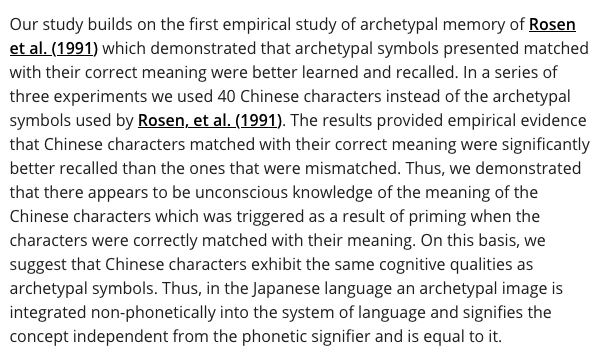
“Our study builds on the first empirical study of archetypal memory of Rosen et al. (1991) which demonstrated that archetypal symbols presented matched with their correct meaning were better learned and recalled. In a series of three experiments we used 40 Chinese characters instead of the archetypal symbols used by Rosen, et al. (1991). The results provided empirical evidence that Chinese characters matched with their correct meaning were significantly better recalled than the ones that were mismatched. Thus, we demonstrated that there appears to be unconscious knowledge of the meaning of the Chinese characters which was triggered as a result of priming when the characters were correctly matched with their meaning.”
∴ In other words, learning Kanji with a corresponding meaning-word or set of meaning-words first establishes a strong foundation for learning and recall of the given kanji.
[10] Japanese Language Educators’ Strategies for and Attitudes toward Teaching Kanji (2002)
“The attitudes of 251 second language teachers toward kanji and their choices of instructional strategies for teaching kanji were explored in this study. Principal component analysis resulted in the identification of 6 statistically reliable domains representing underlying attitudes toward teaching kanji (cultural tradition, difficulty of kanji, affective orientation, aptitudes, usefulness of kanji, and expectation for the future of kanji) and 3 instructional strategies (context, memory, and rote learning). Descriptive statistics revealed that the most positive attitude was toward the “usefulness of kanji” and that the most common instructional strategy was “rote learning.” Canonical correlation revealed a statistically significant correlation between 3 attitude variables—affective orientation, usefulness of kanji, and cultural tradition—and 2 instructional strategies—memory and context strategies. The results showed that: (a) the underlying attitudes toward teaching kanji and teaching strategies were multidimensional and complex, and (b) teachers who appreciated the cultural tradition in kanji and its practical utility tended to have a more positive affect and were more likely to utilize memory and contextual strategies for teaching kanji, although rote learning strategies were the most frequent among all teachers.”
Rote-memorization learning techniques are useful in Japan but not so useful in contexts where adults do not have 8-12+ school years to rote-memorize kanji through repetitious writing. ∴ It makes more sense to teach kanji via expansion on etymology, cultural context, and helpful mnemonic aides because one will learn faster, more effectively, and retain the understanding longer.

[*] Did You Know?
It’s harder to remember rote-memorized kanji with your hands tied.
If you tie a native Japanese speaker’s hands and fingers behind their back and ask them to explain the stroke order of some complex kanji with many strokes, they will struggle. Due to rote-memorization techniques, people who grew up in the classical pedagogical system of Japan will rely on their muscle memory to recall how to draw complex ideograms and logographs [kanji]. If one learned kanji via a mnemonic-and-creative-visualization technique, one will not have this impediment.
[11] Learning strategies employed for learning words written in Kanji Versus Kana (2001)
https://benjamins.com/catalog/aral.24.2.01kub
“The aims of this paper are: (1) to compare learning strategies employed to memorize the meaning of words written in kanji (logograph) and kana (syllablics); and (2) to identify effective learning strategies to memorize meanings of words in kanji. […] The findings were: (1) seven out of 11 participants employed different strategies for memorizing the meanings of words written in kanji from words written in kana; and (2) recognition of radicals and analysis of whole words were effective for memorizing the words written in kanji.“
∴ Learning smaller graphical components of kanji [what we call “subkanji,” and what are classically called “radicals”] and their meanings aides in recognition of kanji clusters [“words written in kanji”] and their memorization.
[12] The Impact of Flipped Online Kanji Instruction on Written Vocabulary Learning for Introductory and Intermediate Japanese Language Students (2016)
https://onlinelibrary.wiley.com/doi/abs/10.1111/flan.12222
“Consequently, a substantial portion of kanji instruction can be shifted to self‐paced, semi‐structured online learning with no negative impact on instructional quality.”
[13] The challenge of motivation: Teaching Japanese kanji characters to students from diverse language backgrounds (2012)
http://library.oapen.org/bitstream/handle/20.500.12657/33174/560110.pdf?sequence=1#page=152
“This research aimed to investigate whether there were significant differences in interest and motivation in the use of learning strategies, and in achievement in the study of kanji at an elementary level among students with different language backgrounds.”
“Moreover, there were significant differences in the use of some learning strategies between the Chinese students and the local students. For example, local students favoured the use of flashcards but this was not a Chinese students’ preferred strategy. However, the practice of using kanji in real communication through mail and blogs was more appreciated by the Chinese students than by the local students. These findings clearly suggest that some learning strategies may be more appropriate for a particular group of students than for other groups, depending on their backgrounds.”
“Implementing a learner-centred approach helps all students to learn what they want and need to learn at their own pace, and thus more computer-aided-language-learning materials should be made available to enrich opportunities for learning and generate appropriately targeted learning activities. Furthermore, in order to fulfil the needs of those students who are motivated to advance their already competent levels of command, it is essential that teachers design and implement autonomous learning for enhancing students’ competence and improving their written communication. For all these reasons, successful teaching of Japanese and other Asian foreign languages now demands that teachers rise to the challenge of exploring and engaging with students’ diverse learning capacities and motivations, if they are to meet their students’ integrative and instrumental needs in today’s globalised university programs.”
[14] KANJI INSTRUCTION AT A JAPANESE SUPPLEMENTARY SCHOOL IN THE U.S. (2008)
http://128.171.57.22/bitstream/10125/20517/1/M.A.CB5.H3_3511_r.pdf
“For example, Flaherty & Noguchi (1998) propose 9 two kanj teaching methods, the Whole-kanji method and Component Analysis method. The Whole-kanji method involves memorizing kanji as a whole by reading controlled passages and writing each kanji separately. This method is commonly used in elementary schools in Japan. The Component Analysis method involves splitting kanji into single components. It is suggested that by giving meanings to each component and memorizing the stories that combine the components help learners remember the forms and meanings of kanji. Flaherty and Noguchi examine the effectiveness of both methods and demonstrate the advantage of Component Analysis method over Whole-kanji method in writing kanji accurately and inferring their meanings.”
“Teaching materials that introduce a variety of instructional strategies are helpful to kanji learning in multiple ways. For example, Mori and Nagy (1999) found that having information about both word elements and contexts promotes kanji learning. Hence, training JSS students to utilize the context strategy through a material that includes abundant context would help students become more tactical kanji learners. Furthermore, as discussed earlier, Flaherty & Noguchi (1998) demonstrate that memory strategy, which break: kanji into parts, improves the retention of kanji. Teachers can encourage their students to incorporate the memory strategy into their kanji learning by actually showing them how to apply the kanji. In addition, Mori & Shimizu (2007) found that students tend to perceive kanji difficult and feel helpless if they rely heavily on the rote learning strategy. On the other hand, students who use other strategies perceive that kanji is fun and experienced less confusion. Their study suggests that using strategies other than the rote learning strategy may increase students’ interest in and intrinsic motivation toward kanji.”
“Moreover, the content of the materials should not be completely separated from the students’ lives. The materials must “draw students’ interest and give dreams to them” (Nakajima, 1998, p.I64). As Aoki (2000) suggests, it is necessary to relate kanji to the students’ lives so they can appreciate the pleasure of kanji.”
[15] Understanding The Basic of Kanji’s Meaning through Mnemonic Method Learning (2017)
“It is commonly assumed and claimed that learners with no prior knowledge of Chinese characters often find it more difficult to learn kanji than learners from character backgrounds(Ishida, 1986; Machida, 2000; Toyoda, 1995). It makes kanji being a burden or something dreaded by Indonesian JFL.According to Hayashi & Yano (1994), Kanji has a lot of characters and the foreigners who do not use to handling such large sets of character in everyday life is not used to it, so it’s hard to remember.This research is to answer the question about the difficulty of Indonesian JFL to memorize the meaning of events in Japanese kanji.This study uses mix method design with30 Indonesian JFL the second semester students of Japanese education department Indonesia University of Education.The results of the analysis revealed that leaning Kanji through mnemonic method seemed to help students to understand kanji’s meaning and the way to read it. The statement was also supported by the students’ response saying that the learning process with Mnemonic method was interesting and enjoyable.”
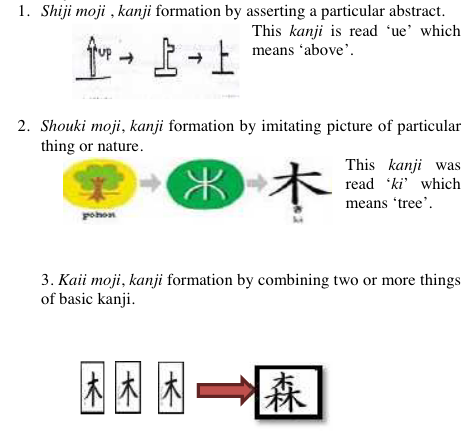
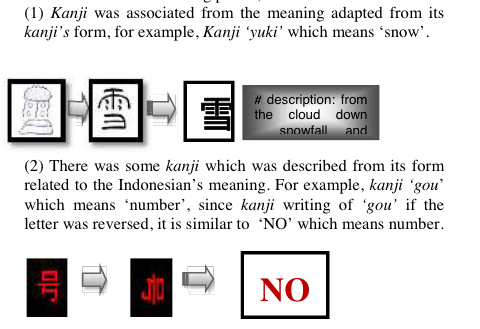
[16] The Processing and Structure of Kanji and their Implications for Kanji Acquisition: a Theoretical Approach to Kanji Literacy (2015)
http://shelf1.library.cmu.edu/HSS/2016/a1761941.pdf
“This paper proposed that kanji literacy depends on four components: orthographic recognition, character production, Japanese linguistic knowledge and connects, and the ability for these three things to be retained in memory (as well as perhaps experience with kanji in a realistic and practical setting). A critical analysis of three existing teaching methods found that two of the more common ones, rote memorization and mnemonics, do not satisfy these four criteria to a significant degree and thus cannot, on their own, be considered practical methods. The third method, radical analysis, showed significantly more promise, but also had a couple significant drawbacks suggesting a need for supplementation from another method. Evidence of kanji processing and kanji structure revealed a low measure of kanji modularity and found that kanji are processed in terms of phonetic, orthographic, and semantic information, at both a holistic and componential level. In considering the drawbacks of various methods and the nature of kanji and kanji processing, a novel method was introduced that answers many shortcomings of other methods, is consistent with what we know about how kanji are processed, and shows significant promise in (at least) three of the four factors of kanji literacy.”
“Section 3: Orthographic Gradient In order to combine semantic information, phonetic information, and orthographic information, without going outside the domain of written Japanese, I propose a method called and orthographic gradient (OG). The premise of OG takes advantage of the multiple scripts used in written Japanese to teach kanji in a textual setting by presenting a passage which starts out entirely in kana (and previously learned kanji), and gradually transitions to being entirely in kanji (for words that have kanji spellings). Each passage would have some number of target words; these may or may not be words that the learner has already encountered, but the point is that they would be words for which the learner has not already learned the kanji spelling. At first, the targets would be written only in kana. At an intermediate stage, the words’ kanji would be introduced, and the character would be written in both kana and kanji using furigana, small kana letters placed above a character to assist in pronunciation. By the end of the passage, the words would be written only in kanji, with no furigana assistance. As reading of passage continues and meaningful connections are made between the words and the passage, the words are replaced with their kanji equivalents in a manner that makes it clear that the new character is simply representing an already-learned word. For example, if one of the actors in the passage was always referred to as 赤いくま/akai kuma/ “the red bear,” and nothing else in the story was red, then when the reader encounters 赤い熊くま/akai kuma/ “the red bear,” they will be able to connect the dots that熊 is just the kanji representation of くま, and the furigana above the word will help to confirm the learner’s conclusion. Eventually, the crutches of the furigana and of the ‘red’ descriptor will be dropped, but by then the learner will recognize the new character and be able to finish the story completely in kanji.”
∴ This paper suggests the use of an “orthographic gradient” to provide multiple copies of an authentic text where certain terms are hidden or obscured with varying levels of kana and coloration. Highlighting 4 important criteria to meet for kanji understanding.
The orthographic-gradient suggested here would work as follows: The kanji is first entirely masked by Hiragana and Romaji crutch (latin letters), as well as coloration to highlight the term.
Later, the same text is issued with kanji in the same location and with the same coloration, to suggest to the reader where the now-masked term was.
While this would show promise for small terms and specifically color-words in Japanese, the amount of information that can be conveyed between separate instances of reading seems leaky. However, the use of the term “orthographic gradient” is most welcome, as it aligns parallel to our notion of “Kanji in English Context” — a novel approach for teaching the plurality of kanji meanings utilizing L1 (the native language) of an L2 Japanese learner (Japanese as a second language).
[17] Computer Assisted Pronunciation Training for Native English Speakers Learning Japanese Pitch and Durational Contrasts (2004)
“This study assessed the efficacy of a pronunciation training program that provided fundamental frequency contours as visual feedback to native English speakers acquiring Japanese pitch and durational contrasts. Native English speakers who had previously studied Japanese for 1–5years in the United States participated in training using Kay Elemetrics’ CSL-Pitch Program.The training materials were words, phrases, and sentences that contained Japanese pitch and durational contrasts. During training the subjects practiced matching the fundamental frequency contours of Japanese-native models shown on a computer screen. The subjects’ ability to produce and to perceive novel Japanese words was tested in two contexts, that is,words in isolation and words in sentences, before and after training. Their ability was compared to that of a native English control group that had previously studied Japanese for 1–5 years but did not participate in the training. The trained subjects improved significantly for words in sentences as well as for words in isolation. Also, the trained subjects improved significantly in perception as well as in production. These findings suggest that the pronunciation training program developed and used here was effective in improving the ability of native English speakers to produce and perceive Japanese pitch and durational contrasts.”
∴ Suggesting that pitch contour and pitch accent can be trained and learned swiftly effectively with study of audio waveforms as well as a listen-and-repeat or repeat-over-the-playback approach.
Samples from Japanese Complete
Sample: Japanese Complete Kanji Lesson

Sample: Japanese Complete Kanji in English Context Lesson
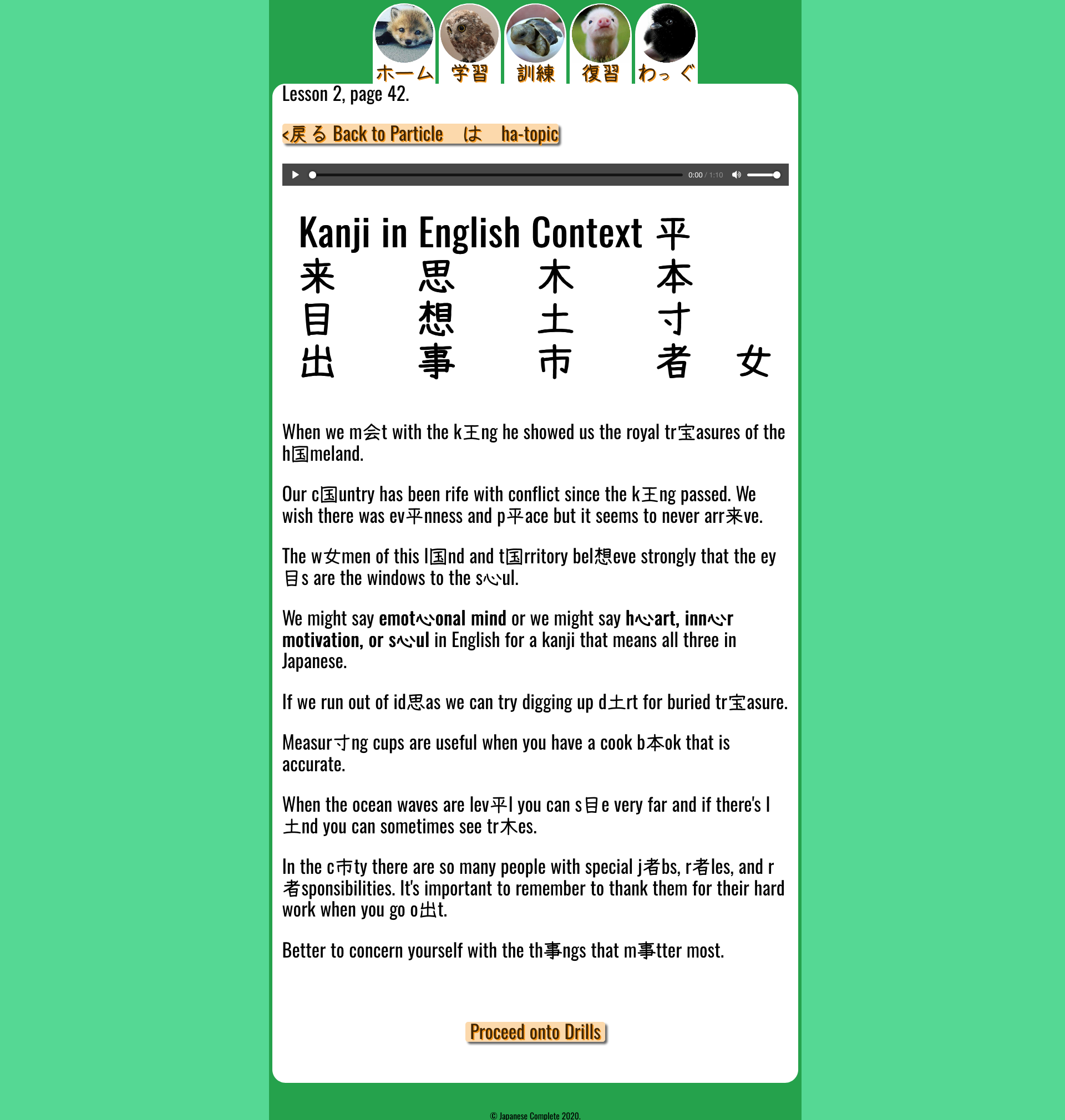
Sample: Dialogues from Japanese Complete featuring “orthographic gradients” for assimilation
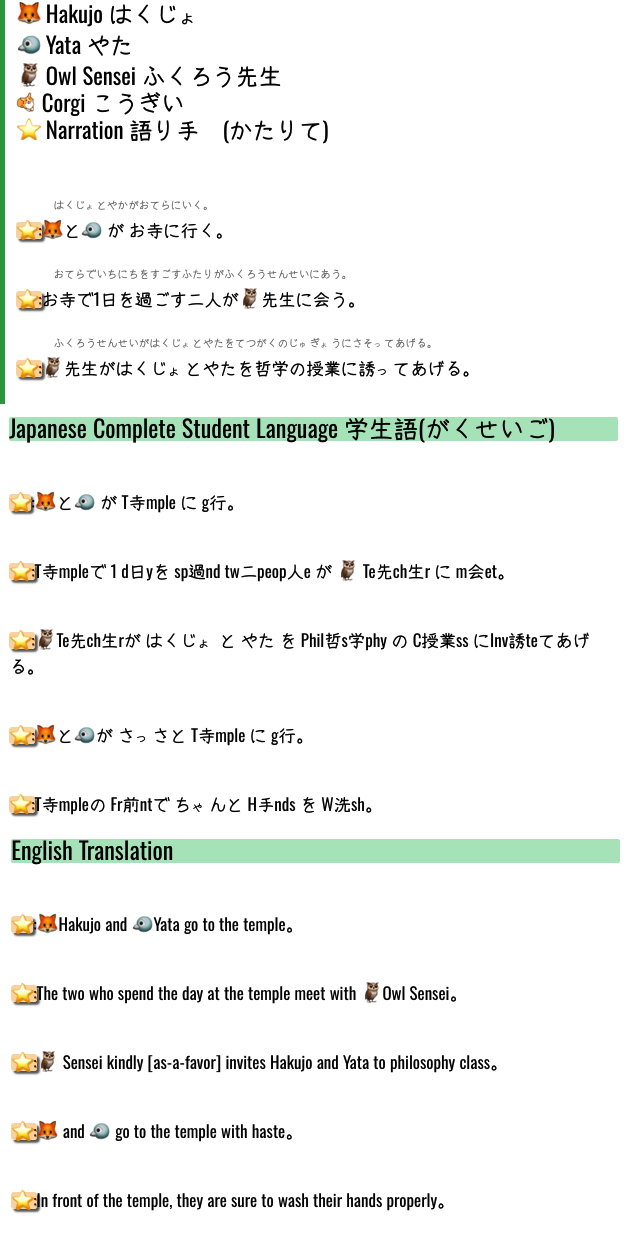

Open the d戸戸rway to understanding Japanese language and culture.
Syn要psis
In short, we find that academic research of the last 30 years overwhelmingly supports our methods and techniques for Japanese language acquisition and assimilation.
Our users self-report high levels of confidence and continued interest in learning Japanese, suggesting that our methods are superior to conventional and traditional pedagogical methods employed in Japan that are not easily or conveniently transplanted into another culture.
Check out the Japanese Complete overview to learn more about our novel and innovative methods featured in Japanese Complete: audio lessons, drawing the kanji after learning mnemonics and etymology, Kanji in English Context, and dialogues with orthographic gradients [Japanese, JPC Student Language, and English]. Start mastering Japanese with ample grammar explanations, fun and intriguing kanji lessons, and quizzes and drills to ensure you have retained what you have learned.
Get a copy of our guide “The Mental Model,” free to help with getting started for understanding Japanese grammar and the flexibility inherent in the language.
Read our Japanese in EBNF grammar article to see how Japanese and computer science can complement one another.

